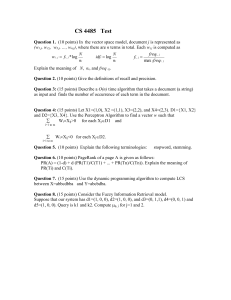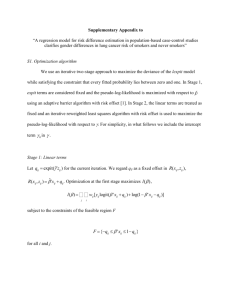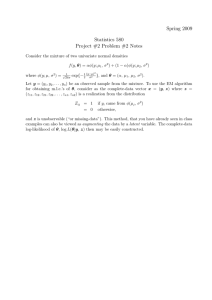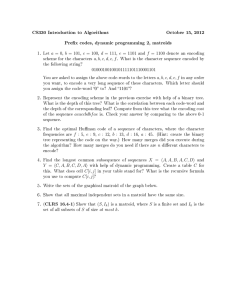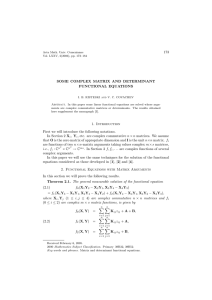Document 13449626
advertisement
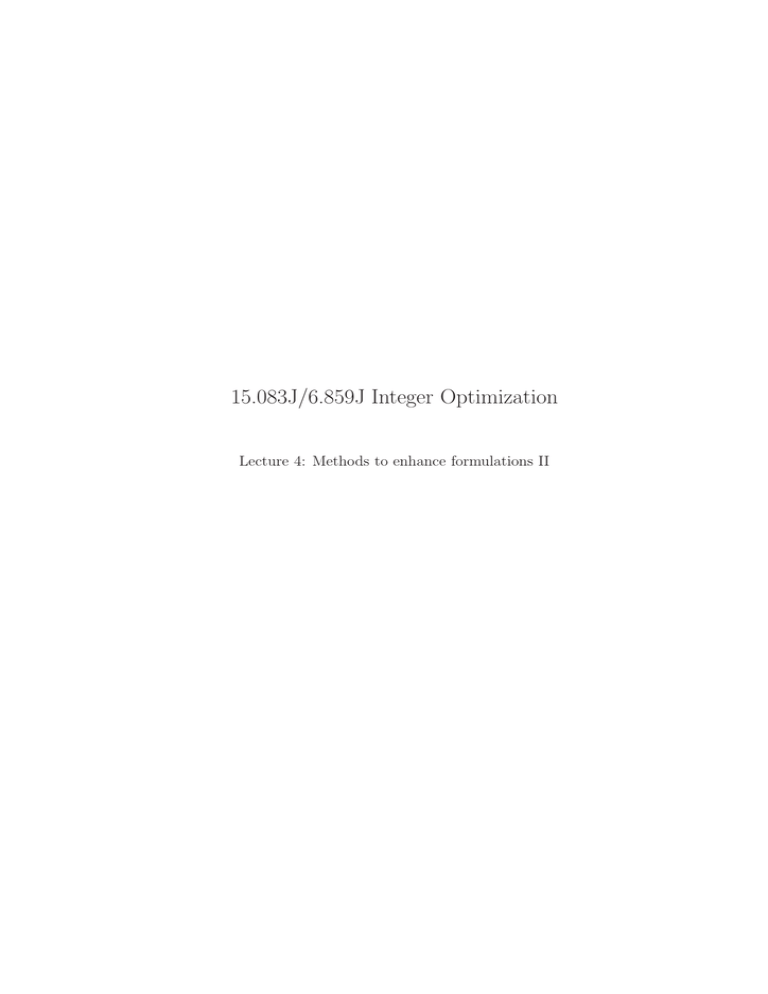
15.083J/6.859J Integer Optimization
Lecture 4: Methods to enhance formulations II
1
Outline
• Independence set systems and Matroids
Slide 1
• Strength of valid inequalities
• Nonlinear formulations
2
Independence set systems
2.1
Definition
• N finite set, I collection of subsets of N .
Slide 2
• (N, I) is an independence system if:
(a) ∅ ∈ I;
(b) if A ⊆ B and B ∈ I, then A ∈ I.
• Combinatorial structures that exhibit hereditary properties
2.2
Examples
• Node disjoint paths; G = (V, E), I1 collection of node disjoint paths in G.
(E, I1 ) is IS. Why? Slide 3
• Acyclic subgraphs. I2 collection of acyclic subgraphs (forests) in G = (V, E).
(E, I2 ) is IS. Why? • Linear independence; A matrix; N index set of columns of A; I3 collection of
linearly independent columns of A. (N, I3 ) is IS. Why? • Feasible solutions to packing problems. S = {x ∈ {0, 1}n | Ax ≤ b}, A ≥ 0,
N = {1, 2, . . . , n}. For x ∈ S, A(x) = {i | xi = 1}. I4 = ∪x∈S A(x). (N, I4 ) is IS. Why?
2.3
Rank
Slide 4
• (N, I) independence system
• An independent set of maximal cardinality contained in T ⊆ N is called
a basis of T . The maximum cardinality of a basis of T , denoted by r(T ),
is called the rank of T .
• S ⊆ T ; |A| = r(T ). A ∩ S and A ∩ (T \ S) are independent sets contained
in S and T \ S
• r(S) + r(T \ S) ≥ |A ∩ S| + |A ∩ (T \ S)| = |A| = r(T ).
1
2.4
Matroids
• (N, I) is a matroid if: Every maximal independent set contained in F has the
same cardinality r(F ) for all F ⊂ N .
Slide 5
• (E, I1 ) (node disjoint paths in G). Is (E, I1 ) a matroid?
• F = {(1, 2), (2, 3), (2, 4), (4, 5), (4, 6)}. Maximal independent sets in F : {(1, 2),
(2, 4), (4, 5)} and {(1, 2), (2, 3), (4, 5), (4, 6)}.
• Is (E, I2 ) of forests a matroid?
• (N, I3 ) of linearly independent columns of A is a matroid.
T ⊂ N index of columns of A, AT = [Aj ]j∈T . r(T ) = rank(AT ).
• Is (N, I4 ) of feasible solutions to packing problems a matroid?
2.5
Valid Inequalities
Slide 6
• C ⊆ N a circuit in (N, I).
maximize
subject to
c x
xi ≤ |C| − 1 for all C ∈ C
i∈C
• Rank inequality
x ∈ {0, 1}n .
i∈T
xi ≤ r(T )
• BW contains conditions for rank inequalities to be facet defining. For matroids,
rank inequalities completely characterize convex hull.
3
Strength of valid inequalities
Slide 7
• S set of integer feasible vectors.
• Pi = {x ∈ n
+ | A i x ≥ bi }, i = 1, 2, A i , bi ≥ 0; covering type polyhedra.
• The strength of P1 with respect to P2 denoted by t(P1 , P2 ) is the minimum
value of α > 0 such that αP1 ⊂ P2 .
• P1 = {x ∈ R | x ≥ 0}, P2 = {x ∈ R | x ≥ 1}. Strength ?
3.1
3.1.1
Characterization
Theorem
• αP1 ⊂ P2 if and only if for all c ≥ 0, Z2 ≤ αZ1 , where Zi = min c x: x ∈ Pi .
• Proof If αP1 ⊂ P2 , then Z2 ≤ αZ1 for all c ≥ 0.
• For converse, assume Z2 ≤ αZ1 , for all c ≥ 0, and there exists x0 ∈ αP1 , but
/ P2 .
x0 ∈
• By the separating hyperplane theorem, there exists c: c x0 < c x for all x ∈ P2 ,
i.e., c x0 < Z2 .
• x0 ∈ αP1 , x0 = αy 0 , y 0 ∈ P1 . Z1 ≤ c y 0 , i.e., αZ1 ≤ c x0 , and thus αZ1 < Z2 .
Contradiction.
• t(P1 , P2 ) = supc≥0
Z2
.
Z1
2
Slide 8
3.1.2
Computation
Pi = {x ∈ n+ | a�i x ≥ bi , i = 1, . . . , m}, and ai ≥ 0, bi ≥ 0 for all i = 1, . . . , m.
Then,
bi
t(P1 , P2 ) = max
,
i=1,...,m di
Slide 9
where di = min a�i x: x ∈ P1 . (If di = 0, then t(P1 , P2 ) is defined to be +∞.
3.2
Strength of an inequality
• The strength off x ≥ g, f ≥ 0, g > 0 with respect to P = {x ∈ n
+ | Ax ≥ b}
of covering type is defined as g/d, where d = minx∈P f x.
• By strong duality,
d = max
s.t.
Slide 10
b p
A p ≤ f
p ≥ 0.
• p feasible dual solution. b p ≤ d. Then, the strength of inequality f x ≥ g with
respect to P is at most g/(b p).
4
Nonlinear formulations
n
ZIP = min
j=1
n
s.t.
Slide 11
cj xj
Aj xj = b
j=1
xj ∈ {0, 1}.
4.1
SDP relaxation
• Multiply each constraint by xi :
n
Slide 12
Aj xj xi = bxi .
j=1
• Introduce zij = xi xj .
zii = x2i = xi
∀ i = 1, . . . , n.
xi xj ≥ 0 ⇐⇒ zij ≥ 0
∀ i, j; i = j.
xi (1 − xj ) ≥ 0 ⇐⇒ zij ≤ zii
∀ i, j, i = j.
(1 − xi )(1 − xj ) ≥ 0 ⇐⇒ zii + zjj − zij ≤ 1
∀ i, j, i =
j.
• Matrix Z = xx is positive semidefinite, Z 0, i.e., for u ∈ n ,
u Zu = ||u x||2 ≥ 0.
3
4.2
SDP relaxation
ZSD = min
n
Slide 13
cj zjj
j=1
n
s.t.
Aj zij − bzii = 0,
i = 1, . . . , n,
j=1
n
Aj zjj = b,
j=1
0 ≤ zij ≤ zii ,
i, j = 1, . . . , n, i =
j,
0 ≤ zij ≤ zjj ,
i, j = 1, . . . , n, i =
j,
0 ≤ zii ≤ 1,
j = 1, . . . , n,
zii + zjj − zij ≤ 1
i, j = 1, . . . , n, i =
j,
Z 0.
ZLP ≤ ZSD ≤ ZIP .
4.3
Why?
Stable set
ZIP = max
n
Slide 14
wi xi
i=1
s.t.
ZSD = max
n
xi + xj ≤ 1,
∀ {i, j} ∈ E,
xi ∈ {0, 1},
i ∈ V.
wi zii
i=1
s.t.
∀ {i, j} ∈ E,
zij = 0,
zii + zjj ≤ 1,
∀ {i, j} ∈ E,
zik + zkj ≤ zkk ,
∀ {i, j} ∈ E,
zii + zjj + zkk ≤ 1 + zik + zjk ,
∀ {i, j} ∈ E,
Z 0.
4.4
Max-Cut
max
Slide 15
wij (xi + xj − 2xi xj )
{i,j}∈E
s.t.
xs = 1,
xt = 0,
xi ∈ {0, 1},
ZSD = max
∀ i ∈ V.
wij (zii + zjj − 2zij )
{i,j}∈E
s.t.
zss = 1,
Z 0.
4
ztt = 0,
zst = 0
Also
0 ≤ zii ≤ 1, zij ≤ zii , zij ≤ zjj , zii + zjj − zij ≤ 1.
4.5
Scheduling
Slide 16
• Jobs J = {1, . . . , n} and m machines.
• pij processing time of job j on machine i.
• Completion time Cj . Objective: assign jobs to machines, and schedule each
wj Cj .
machine to minimize
j∈J
• If jobs j and k are assigned to machine i, then job j is scheduled before job k
on machine i, denoted by j ≺i k if and only if
wj
wk
>
.
pik
pij
4.5.1
Formulation
• xij is one, if job j is assigned to machine i, and zero, otherwise.
• Cj =
m
i=1
xij pij +
k≺i j
•
xik pik ,
minimize
wj
m
j∈J
m
subject to
xij
i=1
pij +
xik pik
k≺i j
∀j ∈ J
xij = 1,
i=1
xij ∈ {0, 1}.
• cij = wj pij ,
⎧
⎪ 0,
⎨
d(ij),(hk) =
if i =
h or j = k,
wj pik
⎪
⎩ wk pij
• x2ij = xij :
ZCP = min
s.t.
if i = h and k ≺i j,
if i = h and j ≺i k,
1 1
c x + x
(D + diag(c)) x
2
2
m
xij = 1,
i=1
0 ≤ xij ≤ 1.
5
∀j ∈ J
Slide 17
MIT OpenCourseWare
http://ocw.mit.edu
15.083J / 6.859J Integer Programming and Combinatorial Optimization
Fall 2009
For information about citing these materials or our Terms of Use, visit: http://ocw.mit.edu/terms.
